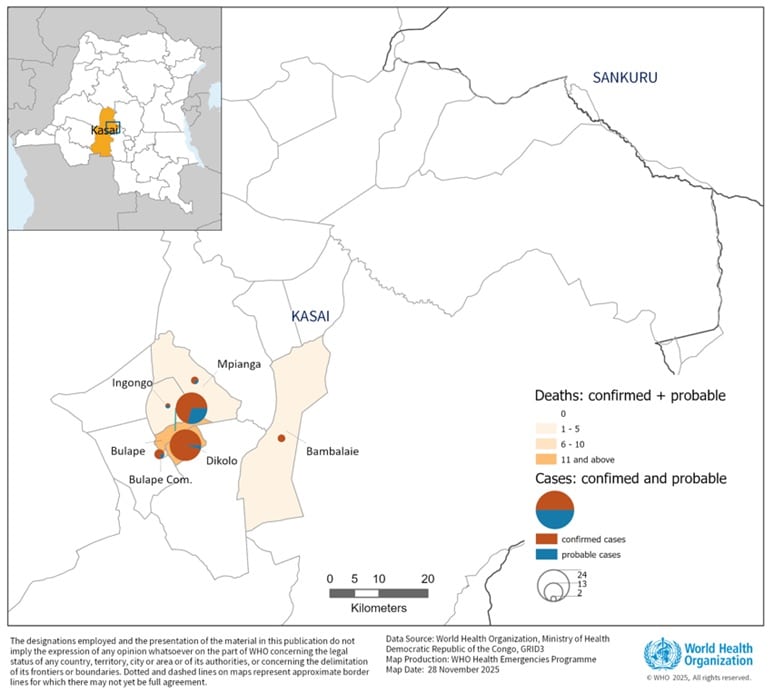Studying drug-resistant TB clusters in Mozambique with DHIS2 Tracker
A six-month research project tracks case-based data in DHIS2 to learn more about resistance to Tuberculosis medication in 2000 patients
Drug-resistant tuberculosis (DR-TB) is acknowledged by the World Health Organization as a public health crisis and a health security threat, both in Africa and in other regions, and it has been identified as a priority research area. The National Tuberculosis Program (NTP) of Mozambique uses DHIS2 to monitor the prevalence of TB throughout the country, primarily through routine collection of aggregate data, which is now being complemented by the ongoing implementation of Tracker for case-based data. In 2020, Mozambique’s NTP partnered with The Global Fund to Fight AIDS, Tuberculosis and Malaria to launch a six-month study on DR-TB with the goal of registering and monitoring approximately 2,000 drug-resistant patients across 50 clusters throughout the country.
With input from WHO and the Health Information Systems Programme (HISP) at the University of Oslo, along with implementation support from Saudigitus (HISP Mozambique), a DHIS2 Tracker system was customized and deployed to help testing, tracking and analyzing these TB cases. This project serves as a useful source of research data, and as a successful pilot of a standardized TB DRS metadata package for DHIS2 that adheres to WHO guidelines and can be downloaded and used by any country in the world.
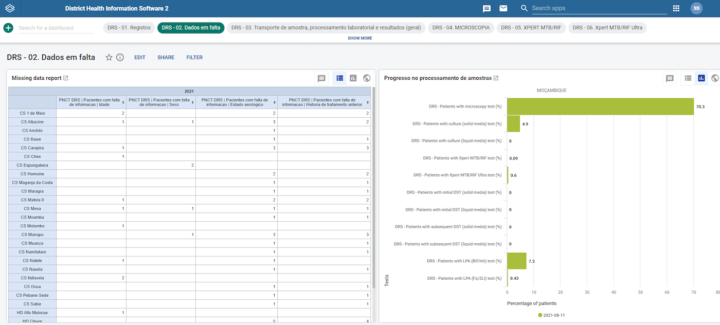
Using DHIS2 Tracker and custom line listing application to support lab follow-up and analysis needs
Mozambique’s national TB program began discussing the TB DRS survey in November 2019. The goal was to perform a study to evaluate the prevalence of the resistance to medications of TB cases, with resistance to specific medications tracked at the cluster and national level. Approximately 2,000 patients with drug-resistant TB were identified and entered as tracked entities in the DHIS2 TB DRS Tracker created for this survey, which includes around 325 variables (data elements) for each patient. Four test samples are collected from each of the patients and assigned unique IDs in Tracker. These samples are split up and sent to separate laboratory sites for processing (locally at the cluster level, at the national level, and at a lab in Milan for additional validation) so that the results could be compared for greater accuracy. The fact that each sample is linked to a specific patient in Tracker allows the national team to follow up in a targeted fashion in cases where there are problems with a sample or missing data on a patient.
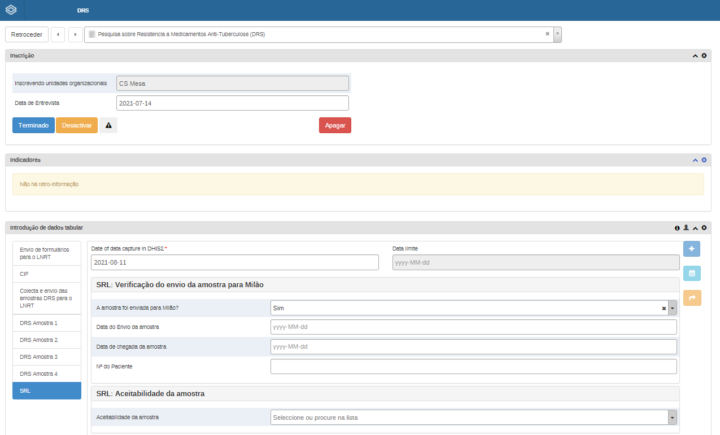
Saudigitus provided training to the TB team at the national level on entering data from paper collection forms into the Tracker system, and has also worked with them to configure the analytics tools within the system to meet their monitoring and reporting requirements. This includes building dashboards within DHIS2 that show the indicators that are most relevant to the Mozambique team, such as the number of patients enrolled, samples collected and date of processing, time taken from sample collection to lab, and percentage of samples rejected.
Saudigitus has also developed a custom web application that allows the NTP to generate a line listing in Excel format with the option to select from all variables included in the stages of the program and display only the variables and attributes desired (within the generic Tracker application, variables can be selected and displayed in line listings per program stage), so that they could see all of their indicators in one place. The successful deployment of this app allows the national TB team to cease duplicate entry of data into Excel and Tracker, saving time and streamlining their processes.
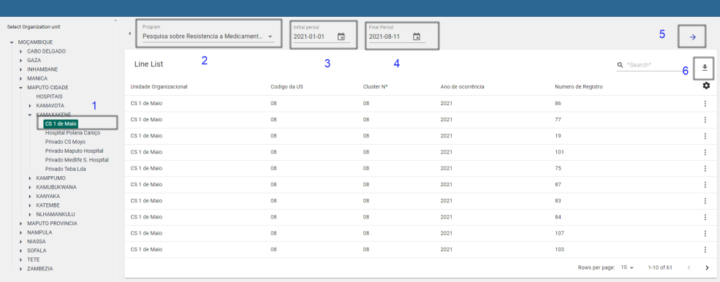
Leveraging experience and local capacity from the TB DRS survey to support deployment of Tracker across health programs
Before the start of the TB DRS survey, Mozambique’s TB program had already been using DHIS2 to monitor simple and drug-resistant patients using DHIS2 for aggregate and Tracker programs side-by-side. The Global Fund provided support for deploying DHIS2 at all TB sites in the country, including providing infrastructure support such as mobile devices for data collection (tablets) and internet. However, the national DHIS2 TB Tracker rollout had faced some implementation challenges, and some facilities had not yet started using it by the time the TB DRS survey began. The successful use of a standalone Tracker program for this survey has helped create additional buy-in for Tracker among national TB program stakeholders in Mozambique as it has demonstrated how Tracker allows for complete TB Surveillance. Additionally, the training provided by Saudigitus has helped build technical capacity in the national TB team that can be leveraged across programs.
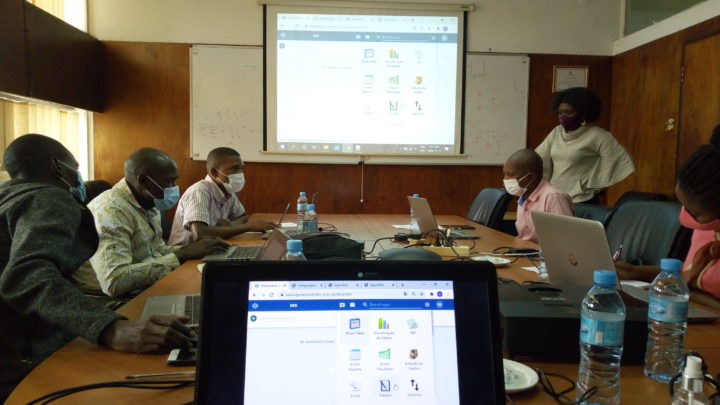
Once their standard TB Tracker implementation is complete, Mozambique plans to link the TB DRS Tracker to their overall system to facilitate monitoring, analysis and follow up across programs. Saudigitus has already laid the groundwork for this integration, such as by configuring the TB DRS Tracker to include unique IDs for clusters and patients that are shared between the two databases. In addition to TB, several other deployments of Tracker are underway in Mozambique. The EPI program is implementing the DHIS2 COVID-19 vaccine package and is in the process of implementing the DHIS2 eRegistry for immunization (including HPV, BCG, etc.) using Tracker. The National Disease Surveillance unit is working on expanding on their DHIS2 COVID-19 implementation to include eIDSR (electronic Integrated Disease Surveillance and Response) programs for additional diseases such as Neonatal Tetanus, Yellow Fever and Measles. Meanwhile, the Ministry of Health already uses Tracker in their national Malaria information system for surveys and supervision, and is now expanding into tracking individual Malaria cases at the community level.
Learnings from Mozambique contribute to the development of a global TB DRS package — and the global good
The TB DRS Tracker configuration used in Mozambique was developed in collaboration with HISP UiO based on global WHO standards. The pilot of this configuration in Mozambique provided valuable insights and feedback that were used to refine this configuration, which is now available as a pre-configured metadata package that can be downloaded and installed in any DHIS2 system, where it can be further configured to meet local requirements. Visit the Metadata Package Downloads page for more information package design, installation guidance and links to downloadable files.
